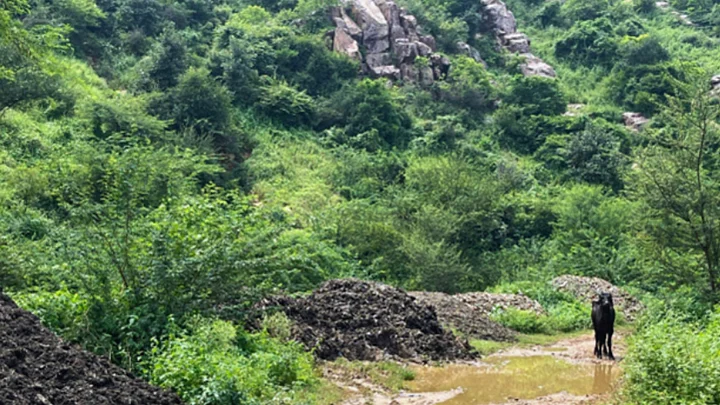The Wastelands of Delhi NCR: The Human Cost of Urban Aesthetics
The stories of landfills like Bhalswa, Ghazipur and Bandhwari show how the state chooses to manage waste in ways that perpetuate social inequalities and deepen marginalisation.

The Wastelands of Delhi NCR: On 2nd October 2014 the Swachh Bharat Mission was launched with great pomp and show to make India a “Clean India” by 2019. While the campaign promised a radical approach to waste management ten years later Delhi NCR exposes the deep contradictions of urban development, i.e. the city thrives while its waste is pushed to its peripheries where it wreaks havoc on marginalised communities.
The stories of landfills like Bhalswa, Ghazipur and Bandhwari show how the state chooses to manage waste in ways that perpetuate social inequalities and deepen marginalisation.
These landfills far from the city’s gleaming landscapes reveal how the state actively creates and sustains informal spaces of neglect where law and regulation is absent and vulnerable communities are left to deal with toxic environments.
The Bandhwari landfill on the Gurugram-Faridabad highway is a perfect example of this governance failure. Meant to hold only processed waste Bandhwari has become a giant dump of unsegregated trash.
Joginder, a resident of nearby Mangar village and a supervisor at the landfill points to the environmental disaster unfolding 35 km from Delhi. “Yes this landfill gives us work but should that be above our health?” he asks.
The Swachh Bharat Mission 2.0 (SBM-U) launched in 2021 to make India’s cities garbage free is yet another example of the gap between the political rhetoric and ground reality. The mission aimed to process the legacy waste and get rid of the “mountains of garbage” that dot cities like Delhi. The government even promised a dashboard to monitor progress across 2200 landfill sites.
Two years since the plan was announced and there is no dashboard and landfills like Bandhwari are still inefficient and neglected.
At the root of the Bandhwari crisis is the non implementation of waste segregation at source. Since 2010 Bandhwari has been receiving over 1600 tonnes of mixed waste daily but only a small fraction is being processed.
A 2017 tripartite agreement between the Haryana government, Municipal Corporation of Gurugram (MCG) and Eco Green Recycling Pvt Ltd was supposed to improve waste management but the company has failed to fulfill its obligations and hence the dumping of unprocessed waste continues.
By September 2024 MCG told the National Green Tribunal (NGT) that 85% of Gurugram and 80% of Faridabad waste is unsegregated and the landfill is overflowing.
This is what is happening in Bhalswa where the informal labour of waste-pickers is keeping the city’s waste problem at bay but at a huge human cost. Migrants from rural West Bengal waste-pickers live in makeshift homes made of scrap material and their children are forced to work with them as there is no alternative.
These workers are invisible to the state despite being the backbone of the city’s waste management. No formal contracts, no rights, no protections, no fixed incomes. As scholar Barbara Harris-White says “informal spaces are persistently embedded in social institutions such as caste, ethnicity, religion, space and locality”.
In Bhalswa this informality is not a natural consequence but a deliberate choice by the state to keep these workers on the margins.
The state’s selective application of regulation is most evident in its handling of Eco Green the company responsible for waste management and segregation at Bandhwari. Despite Eco Green’s repeated failures it continued to operate for years without accountability and it’s an environmental and public health disaster.
MCG finally terminated Eco Green’s contract in June 2024 but the damage was done. Unchecked dumping of unsegregated waste has contaminated the soil and water and toxic leachate is seeping into the Aravalli hills. This pollution has been happening for years and is poisoning the land and water that local communities depend on for survival.
In Bandhwari villagers like Joginder are technically part of the formal waste management network but their position is equally precarious. They are close to government officials and promises of interventions like RO systems to mitigate groundwater contamination give them a sense of state presence. But these solutions only add to the financial burden of the workers.
HSPCB told NGT in May 2024 that almost all locations around Bandhwari had groundwater contamination beyond safety limits. But just two months prior to that MCG had declared the water safe for consumption and dismissed the villagers’ concerns who were saying there was a “faint rotten smell” in the water near the sacred Bani forest.
Jal Jeevan Mission which declared 100% water connectivity in rural Haryana has failed to address the actual water quality in these areas. Villagers are forced to rely on RO systems which break down frequently or buy 20-litre water cans adding to their expenses.
Also Read: Ajay Jadeja Speaks on Pandya's Future: Is Hardik Pandya To Be Released By Mumbai Indians?
Environmental Impact Assessments (EIAs) are supposed to assess such impacts but have become mere formalities.The EIA filed by MCG for Bandhwari’s proposed solid waste processing unit in 2018 didn’t inform the villagers during the public hearing which is a crucial part of the process.
Despite MCG assuring during the hearing that leachate treatment will be done first, the plan is still not finalised as of December 2023 and air pollution control devices promised by MCG was never implemented.
Waste pickers are marginalized by a system that doesn’t formalize their work. They are denied the protections and rights that comes with formal recognition of their work and are vulnerable to exploitation by private contractors and intermediaries.
In Bhalswa and Bandhwari we see how the state creates informal spaces where certain actors like Eco Green in Bandhwari can operate with impunity and leave vulnerable communities to fend for themselves even though they are critical in managing the city’s waste in Bhalswa.
In Bandhwari, residents say there is a surge in illnesses and healthcare costs have tripled in last few years. Every visit to the doctor costs Rs 1,000 which is a big burden for families already struggling to make ends meet.

The landfill is a stark reminder of the gap between government promises and ground realities.
The deadline to clear the site is December 2024 but for the residents of Mangar and Dhauj who have seen decades of broken promises such deadlines mean nothing.
In recent months villagers have reported that shredded waste from the landfill is being diverted and illegally dumped on the outskirts of their villages making their living conditions worse.
Until the state recognizes the humanity of those living on the margins – those who bear the brunt of urban neglect – the mountains of garbage that define our cities will only keep growing, physically and metaphorically.
Also Read: IBPS RRB Clerk Mains Admit Card 2024 Out: Check how to download
For breaking news and live news updates, like us on Facebook or follow us on Twitter and Instagram. Read more on Latest National News on The National Bulletin


